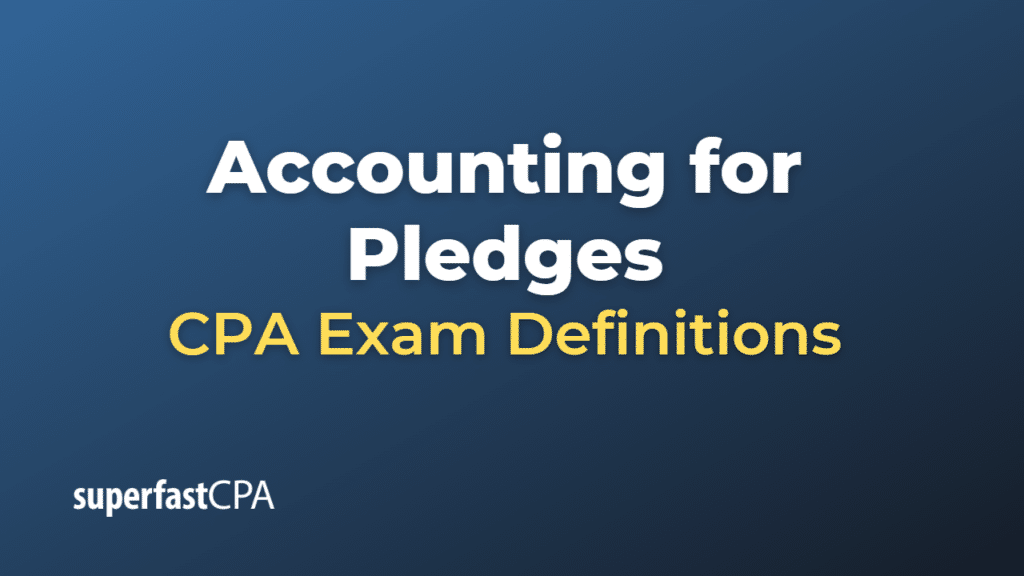Accounting for Pledges
Accounting for pledges involves the identification, recognition, measurement, and disclosure of unconditional promises made by donors (individuals, corporations, or other organizations) to contribute cash or other assets to a nonprofit organization, also known as the donee.
Under U.S. Generally Accepted Accounting Principles (GAAP), accounting for pledges is primarily governed by the Financial Accounting Standards Board (FASB) Accounting Standards Codification (ASC) Topic 958, “Not-for-Profit Entities.
Here are the key aspects of accounting for pledges:
- Identification: Determine if a promise to give represents an unconditional pledge, which means there are no significant barriers or conditions attached to the donation that must be met before the nonprofit can access the funds or assets.
- Recognition: Unconditional pledges should be recognized as revenue when the pledge is made, even if the actual cash or assets have not been received.
- Measurement: Pledges should be recorded at their fair value, which is generally the amount promised by the donor. If the pledge is due to be received in more than one year, the net present value of the future cash flows should be calculated, considering the time value of money.
- Allowance for uncollectible pledges: An estimate of pledges that may not be collected should be recorded as an allowance for uncollectible pledges, reducing the net pledge receivable reported in the financial statements.
- Classification: Pledges can be classified as unrestricted, temporarily restricted, or permanently restricted, depending on the donor’s stipulations or the passage of time.
- Disclosure: Disclose information about pledges, such as the nature and amounts of pledges, any restrictions, the allowance for uncollectible pledges, and the net present value calculations in the notes to the financial statements.
By properly accounting for pledges, a nonprofit organization provides users of its financial statements with an accurate representation of its financial position and performance, considering the future inflows of resources, any restrictions on their use, and the potential risks and uncertainties associated with the collection of pledges.
Example of Accounting for Pledges
Let’s consider an example of a nonprofit organization accounting for pledges.
Example: Nonprofit ABC receives an unconditional pledge of $50,000 from a donor to support its programs. The donor agrees to pay $25,000 immediately and the remaining $25,000 one year later. The organization estimates that 5% of the total pledge amount may be uncollectible. The nonprofit uses a discount rate of 3% to calculate the present value of future cash flows.
Here’s how Nonprofit ABC would account for the pledge:
Step 1:
Recognition: As the pledge is unconditional, Nonprofit ABC recognizes the full $50,000 as pledge revenue when the pledge is made.
Step 2:
Measurement: The present value of the second installment of $25,000 due in one year is calculated using the discount rate of 3%.
| $25,000 / (1 + 0.03) = $24,271 |
Step 3:
Allowance for uncollectible pledges: Nonprofit ABC estimates that 5% of the total pledge amount may be uncollectible, which is:
| $50,000 × 0.05 = $2,500 |
Step 4:
Financial statement impact:
- Pledge revenue of $50,000 is recognized in the statement of activities (income statement), increasing the organization’s total revenues.
- In the statement of financial position (balance sheet), the following amounts are reported:
- Pledge receivable (current portion): $25,000
- Pledge receivable (long-term portion): $24,271 (present value)
- Less: Allowance for uncollectible pledges: $2,500
- Net pledge receivable: $46,771
Step 5:
Disclosure: Nonprofit ABC discloses information about the pledge, any restrictions, the allowance for uncollectible pledges, and the present value calculations in the notes to the financial statements.
By properly accounting for the pledge, Nonprofit ABC provides users of its financial statements with an accurate representation of its financial position and performance, considering the future inflows of resources, any restrictions on their use, and the potential risks and uncertainties associated with the collection of pledges.













